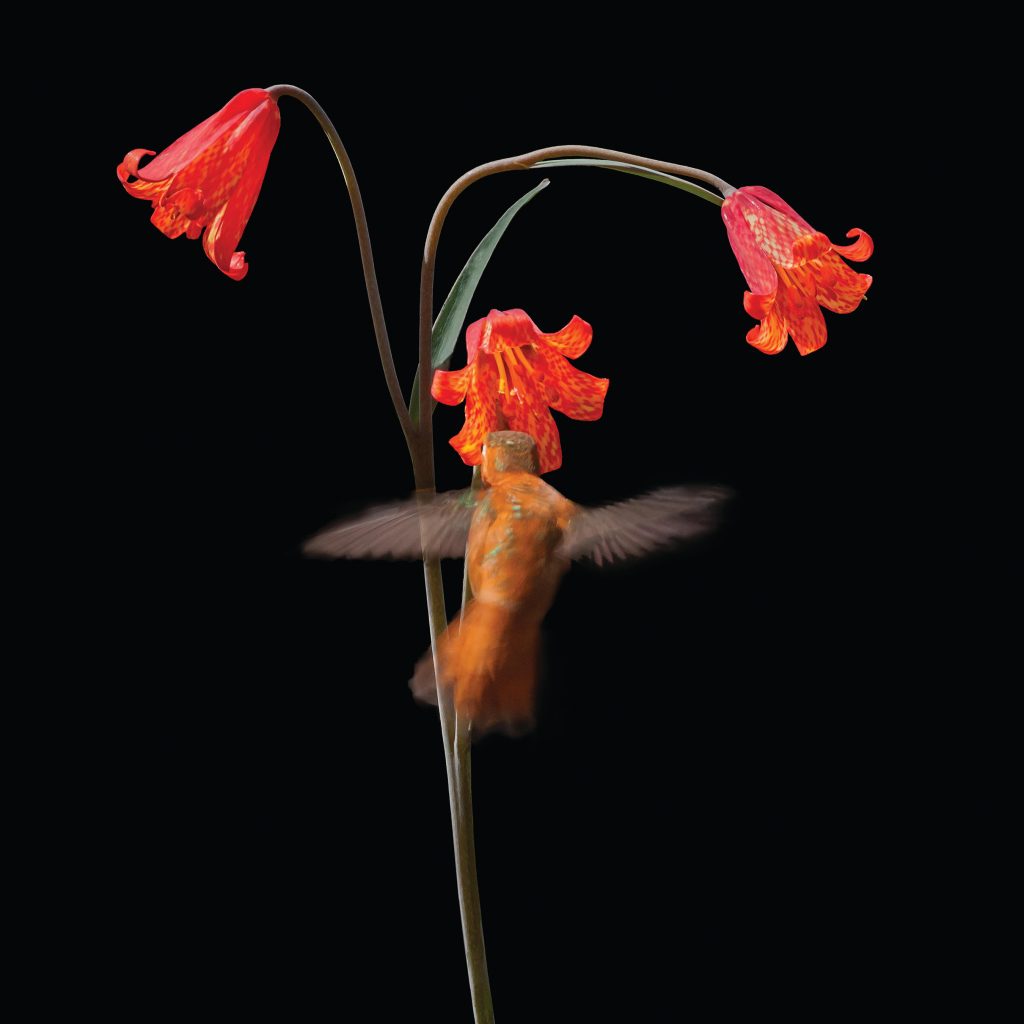On a warm and windy spring day in 1992, I witnessed what was then a rare and spectacular wildflower display in the Antelope Valley California Poppy Reserve, a state park in the western Mojave Desert. I was awestruck by what was before me. During twenty years of photographing the West’s dramatic, iconic landscapes, I had never seen the desert so alive, shimmering with such an explosion of color and life. Experiencing such intense beauty was magnetic, intoxicating, and almost overpowering.
That evening I called home to Nita, my sweetie and fellow photographer. I described as best I could how it felt to see the wind move in waves across a vast sea of glowing, orange California poppies and purple bird’s-eye gilia blossoms. Hearing my excitement, she knew she had to see this for herself. Because these flowers would soon disappear in the drying winds and growing desert heat, I quickly returned to San Francisco, where Nita was between photo assignments. We immediately drove back to the poppy reserve to enjoy and photograph this unbelievable beauty together. We did not know then that this was the beginning of a lifetime adventure exploring and photographing what we believed to be a limitless world of wildflowers.
Nita and I share an intense desire and commitment to using our work in ways that benefit both nature and humanity. For decades, her photographic projects have celebrated human diversity and helped members of underserved communities feel a much-needed sense of pride. For many years, my own work focused on both land conservation and the environmental destruction caused by human activities such as development, logging, and mining. I was becoming discouraged and emotionally burned out by what I witnessed and documented.
Photographing wildflowers opened up a new world for both of us. It allowed us to collaborate in many different ways and brought us closer together as photographers and as partners. Our photography now included both the grand landscape and a variety of ways to capture the world of a single flower. Exploring new areas, developing new skills, and learning more about native plants and where they live consistently brought joy into our lives and really lifted my spirits. Searching for new places and flowers was like a magical treasure hunt, for it seemed that there would always be new wildflowers to discover, photograph, and share.
Over time we were creating a visual story about Nature’s diverse wildflower communities, now surviving primarily on federal, state, county, or local public lands. We documented the spectacular landscapes and created intimate floral portraits—from below sea level in Death Valley National Park to naturally occurring alpine “rock gardens” above 13,000 feet in Colorado’s Rocky Mountains.
In 1998, Nita and I spent a glorious month photographing our first “one-hundred-year-bloom” in Death Valley and Joshua Tree National Parks, and in Anza-Borrego Desert State Park. Then we documented another one in 2005, only seven years later. Our understanding is that until recently, “super blooms” were known as “one-hundred-year blooms”; they occurred only when all the right conditions came together—on average, only about once per century.
Climate change is now creating extreme swings in weather and precipitation, with more frequent years of abnormally high rainfall followed by long periods of severe drought. Although super blooms happen more frequently (as in 2017 and 2019), we learned that drought-stressed native plants and abundant rains make it possible for invasive grasses and other non-native species to move in and quickly take over the wildflowers’ habitat.
We were eager to learn more about the natural history of the flowers and our human behavior, the “beast” that was threatening them.
Concurrently, climate change research was gaining more attention. Across the globe, a growing number of scientists studying and reporting the effects of increased carbon dioxide in the atmosphere were making alarming predictions about the future of life on Earth. Overconsumption by an expanding human population was demanding more land and resources for manufacturing, agriculture, and development. These demands contributed to the reduction or loss of habitats—the many native plants, insects, and animals that depend on them for their survival. Limiting the impact of climate change was becoming the single most important issue to address to prevent species extinction.
Aware of these findings, we were determined to use the strong body of work we had created to promote the protection of wildflowers, their fragile habitats, and all the life that depends on them. Our images can give you a sense of the many different types of flowers that exist and the magnificent landscapes in which they are found. But images alone cannot tell the story; a voice for wildflowers and their natural communities would need something more.
To be that voice, in 2011, we created an ongoing documentary art project, Beauty and the Beast: Wildflowers and Climate Change. It was accepted as a sponsored project by Blue Earth Alliance, an organization that “believes visual storytelling inspires positive change.”
Our purpose was to use art to inspire hope and action—an action that reduces the impact of climate change promotes land and species conservation and encourages the creation of a sustainable population that the Earth can support.
Because people are constantly hearing about all the negative things going on in the world, we believed there was a need for \a different, softer approach to grab people’s attention and center it on the climate change story, conservation, and population issues. We chose to engage our future audiences by first inviting them to experience the splendor of the natural world through a universal symbol of beauty, the wildflower. Our vision was to create artistic coffee table books and exhibits accompanied by short, educational essays. Also provided would be descriptions of simple actions people could take to create positive change.

The first exhibit of Beauty and the Beast: California Wildflowers and Climate Change opened in 2016 at the San Francisco Public Library. Joan Jasper, director of exhibits, invited us to create a collection of photographic prints of California’s botanical heritage. The one-hundred-image exhibit included a series of educational panels that told the wildflowers’ story and encouraged public participation in conservation and climate change issues. A traveling version of the original display is available through Exhibit Envoy, a nonprofit organization that makes affordable exhibits accessible to small and medium-size venues. As of this writing, we are proud to share that ours has been seen by more than 40,000 people.
For the next two years, we worked to create the exhibit’s companion coffee table book to present additional images and, of equal importance, informative and inspiring short essays written by a carefully chosen group of sixteen talented authors. To represent the diversity found in the scientific and conservation communities, we asked experts in their fields, including nature writers, both female and male scientists, and authors of color, to tell Nature’s stories.
We also wanted to offer voices from a wide range of ages. Our youngest author, Kenna Kuhn, wrote, “Hope, Joy, and Inspiration.” As of this writing, she is a twenty-year-old environmental science student and a voice for future generations— those who will be most affected by our actions or inactions. We are also honored to include Dr. Peter H. Raven, president emeritus of the Missouri Botanical Garden, who graciously wrote our foreword and the essay “The Origins of California’s Wonderful Plants.” At eighty-two years old, he is our eldest author/scientist, and, according to Time magazine (2015), he is a “Hero for the Planet.”
We asked each of our authors to write in a personal, storytelling style to give a sense of who they are and why they do what they do. We want to connect with our readers in a more intimate, spiritual, and poetic way, especially when a piece includes important scientific information. Together with our authors, it is our desire that our collective climate and conservation messages inspire more people to act. We hope you’ll experience some of the passion and commitment we all feel for the different paths we take to protect beauty and life on our most precious planet.
We know many of you have questions about how we make our images. The “Behind the Scenes” section in the book explains how, using only natural light, we very carefully create our floral portraits while the living plants remain safe and sound in the ground. We never pick the flowers, and we photograph only plants we can access without harming them or others around them. We ask you to remember to stay on the trails and treat all plants with respect.
It is so difficult to describe what we have felt while experiencing some of the most breathtaking displays of Nature’s beautiful artistry, whether they are dramatic, multi-hued super blooms or the radiant brilliance of a single blossom.
Nita and I have created this book for three important reasons: to give you a sense of what we have been privileged to see that remains of California’s unique botanical diversity;
to make Nature’s many voices heard, and to use documentary art and the written word to inspire both hopes for the future and action. So, as you move through the pages, please take a moment to stop and admire the splendor of California’s wildflowers and where they live… and learn how you can help ensure that these magnificent flowers, and the web of life that supports them, will be here for generations to come.
As artists and activists, we ask: how can humanity ensure that all species can survive and thrive in harmony? How do we humanely and voluntarily create a sustainable population? Some of our answers come from Project Drawdown, described on its website as “one of the world’s leading sources of climate solutions.” According to its research, many strategies (it offers 100) will help reverse global warming and reduce the impact of climate change. Two of the top ten solutions, educating girls and family planning, influence family size and global population. Drawdown states, “Education lays a foundation for vibrant lives for girls and women, their families, and their communities. It also is one of the most powerful levers available for avoiding emissions by curbing population growth. Women with more years of education have fewer and healthier children, and actively manage their reproductive health.”
Therefore, Nita and I envision a world where all girls and boys worldwide receive at least twelve years of schooling and where family planning is universally accepted, and available, and affordable to all. We also see a bright future in which girls and women are truly valued as equal and important members of every family, religion, and culture and are thus empowered to make their own life choices. We believe that achieving these goals will allow our species to humanely and voluntarily shift toward a population the Earth can sustain. Our faith in humanity fuels our optimism.
Since early childhood, Nita and I have always felt a deep love for, and connection, and commitment to the natural world. Hope, commitment, and emotional energy all empower and sustain our life’s work. Our personal and professional goal and life’s purpose is to work with others to inspire conservation and climate change action. Won’t you join us?
Books available at www.wildflowerbooks.com







